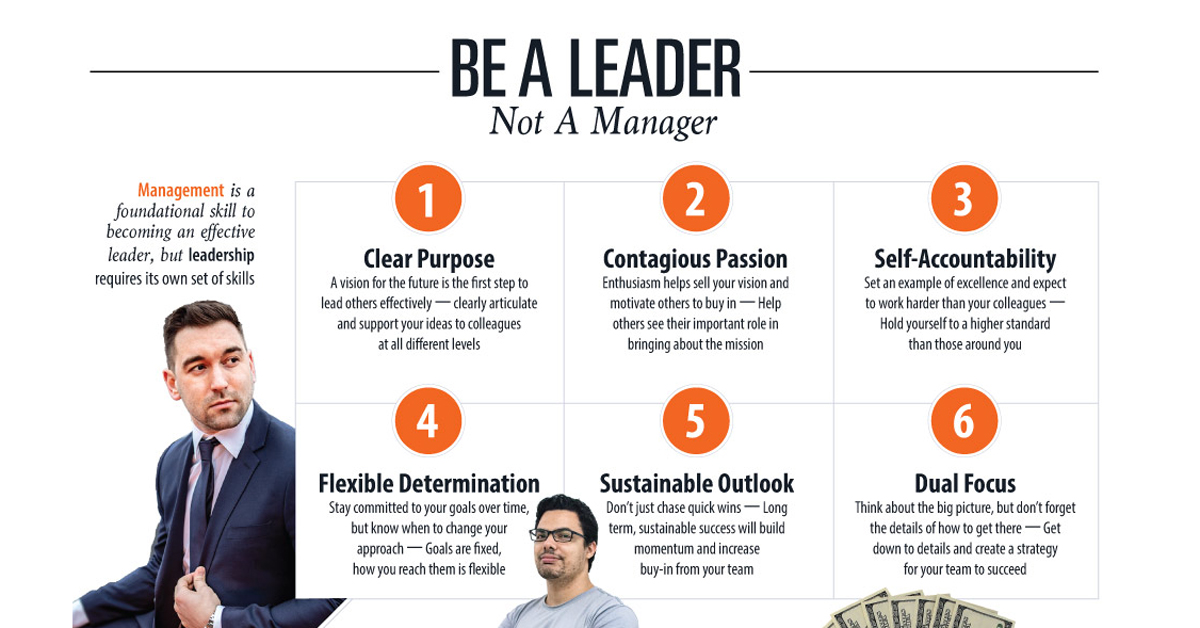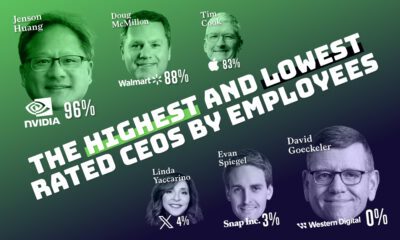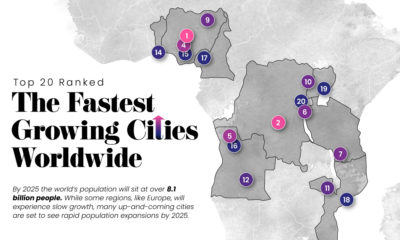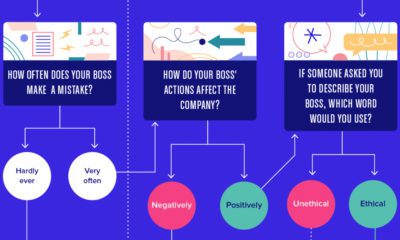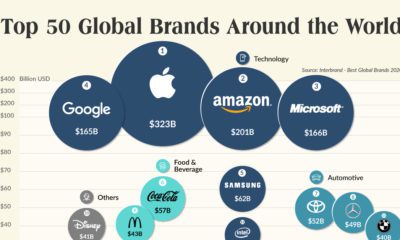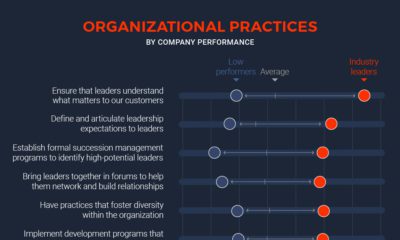Business
The Habits of Highly Effective Leaders

How Strong Leadership Impacts the Bottom Line
Organizations of all shapes and sizes are under immense pressure to retain good talent.
High employee turnover can directly impact a company’s bottom line—with many studies suggesting poor leadership is one of the main causes.
Today’s infographic from Online PhD Degrees explores what it takes to be an strong leader, and the behaviors of poor leaders that should be avoided at all costs.
In today’s rapidly changing world, how can the qualities of a strong leader positively shape a company’s future?
The Benefits of Investing in Leadership
Effective leadership is worth its weight in gold, with 58% of employees claiming they would choose having a great boss over a higher salary.
Not only that, 94% of employees with great bosses feel passionate about their jobーnearly twice as many as those working for a bad boss. A strong leader increases employee loyalty, creating a conducive environment for reaching a company’s goals.
In fact, research shows that companies with strong leaders are crucial when it comes to outperforming industry competitors and are three times more prepared to react to the speed of change. Moreover, a company with a strong leader is almost five times more likely to have higher customer engagement and retention rates.
How to Lead Effectively
While each company has its own processes and demands different skill sets, there are core behaviors that separate leaders from managers:
- Clear Purpose: Clearly articulating the company’s future vision to all levels of staff in a clear and concise way.
- Contagious Passion: While managers light fires under people to motivate them, leaders light fires in people.
- Self-Accountability: The expectation to work harder than employees and set a standard of excellence.
- Flexible Determination: Leaders are agile and open to change.
- Sustainable Outlook: Focusing on long-term goals proves to a team that a leader is invested in the long-haul.
- Dual Focus: Beyond thinking big picture, leaders provide employees with a clear and actionable strategy for success.
Effective leaders are born from this combination of behaviors. However, one of them has the farthest-reaching impact, both on employees and a company’s bottom line: purpose.
Purpose and Performance
The Global Leadership Forecast finds that a strong and well-executed purpose can build organizational resilience and improve long-term financial performance.
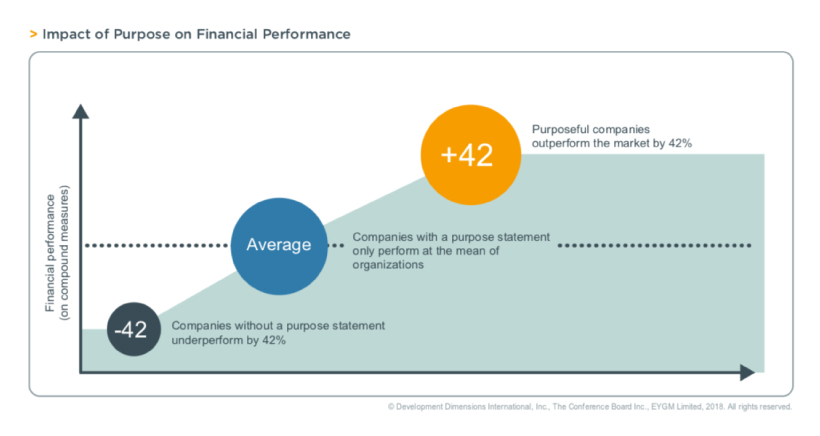
Leaders who amplify an organization’s purpose create a culture of optimism where employees feel safe in proposing new ideas that will shape the trajectory of a company.
The Future of Leadership
To stay competitive, continuous learning and re-skilling should be at the heart of every organization’s leadership strategy. Leaders of the future should possess the ability to redesign jobs in a more fluid way and lean in to the changing nature of work.
“If we don’t disrupt our business, somebody else is going to do it for us.”
—McKinsey Analysts
While management is a foundational skill, organizations need to invest in their leaders to ensure constant growth. Embracing the traits of an effective leader can not only provide improved returns—it also empowers organizations to thrive in an uncertain future.
Technology
How Tech Logos Have Evolved Over Time
From complete overhauls to more subtle tweaks, these tech logos have had quite a journey. Featuring: Google, Apple, and more.

How Tech Logos Have Evolved Over Time
This was originally posted on our Voronoi app. Download the app for free on iOS or Android and discover incredible data-driven charts from a variety of trusted sources.
One would be hard-pressed to find a company that has never changed its logo. Granted, some brands—like Rolex, IBM, and Coca-Cola—tend to just have more minimalistic updates. But other companies undergo an entire identity change, thus necessitating a full overhaul.
In this graphic, we visualized the evolution of prominent tech companies’ logos over time. All of these brands ranked highly in a Q1 2024 YouGov study of America’s most famous tech brands. The logo changes are sourced from 1000logos.net.
How Many Times Has Google Changed Its Logo?
Google and Facebook share a 98% fame rating according to YouGov. But while Facebook’s rise was captured in The Social Network (2010), Google’s history tends to be a little less lionized in popular culture.
For example, Google was initially called “Backrub” because it analyzed “back links” to understand how important a website was. Since its founding, Google has undergone eight logo changes, finally settling on its current one in 2015.
| Company | Number of Logo Changes |
|---|---|
| 8 | |
| HP | 8 |
| Amazon | 6 |
| Microsoft | 6 |
| Samsung | 6 |
| Apple | 5* |
Note: *Includes color changes. Source: 1000Logos.net
Another fun origin story is Microsoft, which started off as Traf-O-Data, a traffic counter reading company that generated reports for traffic engineers. By 1975, the company was renamed. But it wasn’t until 2012 that Microsoft put the iconic Windows logo—still the most popular desktop operating system—alongside its name.
And then there’s Samsung, which started as a grocery trading store in 1938. Its pivot to electronics started in the 1970s with black and white television sets. For 55 years, the company kept some form of stars from its first logo, until 1993, when the iconic encircled blue Samsung logo debuted.
Finally, Apple’s first logo in 1976 featured Isaac Newton reading under a tree—moments before an apple fell on his head. Two years later, the iconic bitten apple logo would be designed at Steve Jobs’ behest, and it would take another two decades for it to go monochrome.
-

 Mining1 week ago
Mining1 week agoGold vs. S&P 500: Which Has Grown More Over Five Years?
-

 Markets2 weeks ago
Markets2 weeks agoRanked: The Most Valuable Housing Markets in America
-

 Money2 weeks ago
Money2 weeks agoWhich States Have the Highest Minimum Wage in America?
-

 AI2 weeks ago
AI2 weeks agoRanked: Semiconductor Companies by Industry Revenue Share
-

 Markets2 weeks ago
Markets2 weeks agoRanked: The World’s Top Flight Routes, by Revenue
-

 Countries2 weeks ago
Countries2 weeks agoPopulation Projections: The World’s 6 Largest Countries in 2075
-

 Markets2 weeks ago
Markets2 weeks agoThe Top 10 States by Real GDP Growth in 2023
-

 Demographics2 weeks ago
Demographics2 weeks agoThe Smallest Gender Wage Gaps in OECD Countries
